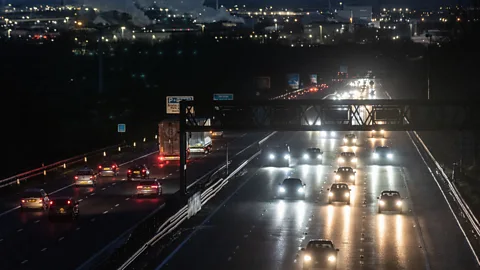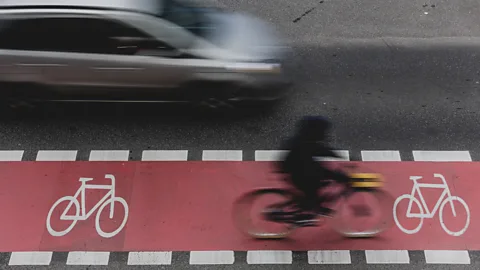'Motonormativity': The bias that leads to dangerous driving
 Getty Images
Getty ImagesCertain personality traits can predispose people to taking more risks on the road – but societal biases also prevent us recognising when our behaviour behind the wheel is becoming reckless.
I drive maybe five days a year. But each time I settle into the driver's seat, I'm quick to fall into old patterns – the itch to go faster, the irritation with delays – that I don't experience as a pedestrian. I'm just a more impatient person behind the wheel. And of course that's also when my impatience is most dangerous.
One analysis of more than 3,500 drivers in the US found that driver-related factors (notably distraction) were involved in nearly 90% of crashes.
A combination of environmental, societal and individual factors helps to explain aggressive driving, says Steven Love, who researches cognitive psychology and road safety at the MAIC/UniSC Road Safety Research Collaboration in Sippy Downs, Australia. In Love's view, aggressive behaviours like speeding and running red lights are influenced by a combination of the traffic environment, the apparent cultural norm of speeding, and how well a driver can manage their own frustration.
The last factor is a key entry point for psychology. "A lot of road safety issues, including DUI [drinking under the influence] behaviours, stem from a greater underlying psychological problem," says Love. "Individuals engage in risky, antisocial and emotion-driven behaviour because they have difficulties regulating their thinking and emotions."
This applies particularly to drivers with trait aggression (a personality tendency toward aggression). Such drivers have low risk perceptions, and are less likely to be deterred by near misses or mild legal punishments. Research from China has also suggested a link between social exclusion and aggressive driving, as drivers take their anger onto the road with them.
The self-perception trap
But it's not just trait-aggressive drivers who perceive themselves to be better drivers than is actually the case. In general, drivers are notoriously bad at judging their own skills – including visually impaired drivers in Sweden and inexperienced male drivers in Finland. US studies have shown that most survey participants consider themselves to be better-than-average drivers.
These inflated self-perceptions are dangerous, in the experiences of Sally Kyd, a criminal law expert at the University of Leicester in the UK. "If drivers have a tendency to view themselves as expert drivers, whose skilfulness is above that of the… average driver," Kyd says, they're likely to drive riskily because they don't consider driving laws to apply to them.
One reason for this gap between actual and self-rated driving behaviour is the discrepancy in beliefs about what constitutes skilful or safe driving. "Our recent studies have suggested that a primary cause to negative road interactions is the friction between various driving styles on the road," says Love. Aggressive drivers call out slow drivers, while patient drivers point to reckless drivers as the problem. Both are frustrated.
 Getty Images
Getty Images"This really highlights the disparity between drivers' perceptions of driving styles that are different to their own," Love says. "As an example, an overconfident driver who holds antisocial attitudes might believe that their speeding is completely safe after accounting for their skill level," he says.
Ana Carboni, a cycling advocate in Brasília, Brazil, sees this attitude often. "I think people don't perceive themselves as part of the equation," she says. A common idea is, she says: "'I'm a good enough motorist that I can drive at any speed, and I'll be fine'. And we know that that's not true." Part of the problem, she believes, is "the difficulty in linking yourself to something bad that happens". Aggressive drivers may use defence mechanisms to protect themselves from such stress.
Deterring dangerous driving
It should be emphasised that reckless driving is enabled by infrastructure and policy that undervalue road safety. "What needs to happen to really bring down speeds more ubiquitously is better road design for reducing speeds in the first place," says Charlie Klauer, who researches driving behaviour at Virginia Tech, a university in Blacksburg, US. The phrase "speed kills" is undeniably true: each 1% increase in average speed raises the risk of a fatal crash by 4%, according to the World Health Organization. Simple and inexpensive changes to road design, from narrowing streets to installing speed humps, save lives by forcing motorists to slow down.
But even though policymakers and planners have the larger role to play when it comes to protecting lives on roads, individual driver behaviour is also significant.
Underestimation of driving risk has ramifications for criminology. Offending drivers with inflated self-perceptions "see themselves as justified in creating risks in their driving", according to Kyd. So no matter how severe the penalty for causing a fatal crash, this is unlikely to deter hazardous drivers who never expect to actually cause a collision, she says.
These expectations can be reinforced every time a motorist has an uneventful drive. Ian Walker, an environmental psychologist at Swansea University in the UK, refers to learning theory, a framework for understanding the learning process. "One of the basic elements of learning theory is that if an action doesn't have consequences immediately, we're very bad at learning," Walker says.
He often says that driving is dangerous, but not quite dangerous enough. In other words, people who drive while texting or intoxicated will probably get away with it a number of times, which reinforces their belief that it's reasonable behaviour. "So people are not getting the feedback they need," Walker says. "The answer to this, of course, is that people should be listening to the experts who look at this at a societal level and not just relying on their own very limited experience," he says.
 Getty Images
Getty ImagesHowever, Walker recognises that this may not be realistic, "because we're not very good at understanding risk," he says.
So what kinds of curbs work for the most resistant, aggressive drivers? "If they are to be deterred, it is the underlying behaviour that needs to be targeted," Kyd says. That is, a driver has to think that they could be caught and disciplined any time they drive dangerously (not only if they crash, which they think won't happen), according to Kyd. Stiffer sentences for dangerous driving should be combined with greater enforcement to increase the chances of catching dangerous drivers before they cause tragedies, says Kyd.
Indeed, increased enforcement has contributed to reductions in road traffic deaths in parts of Brazil, the US, and other car-centric countries. This stepped-up enforcement can face an uphill battle. One reason for leniency toward dangerous driving in many legal systems is the normalisation of illegal practices such as speeding.
Many politicians are hesitant to challenge these practices due to the political influence of motorists – in Italy, for instance, car crashes increase during years with municipal elections, as ticketing slows down. Part of the problem is that authority figures in the criminal-legal system are likely to be drivers themselves, and thus may identify more easily with drivers than with vulnerable road users.
However, tougher law enforcement is not a silver bullet, even if it's implemented in a way that respects privacy and isn't discriminatory. "Policing resources are finite, and aggressive driving behaviours are both prevalent and difficult to detect... increasing fines may deter some offenders, but research has suggested that repeat offenders are generally not deterred from sanctions, likely due to underlying and persisting psychological issues that are influencing the behaviours," says Love. He believes that it could be helpful to incorporate this kind of psychological analysis – for instance, for regulating emotions – into collaborations with transport, public health and educational systems.
Tackling 'motonormativity'
To Walker, psychological insights into road safety should extend not just to individuals, but to entire societies that have dangerous biases around driving.
Something peculiar happens when people in car-centric societies think about driving, Walker says. He points to safety campaigns encouraging children to wear bright clothing so they're seen on the roads. In Walker's opinion, these could be interpreted as teaching children that it's their own fault if they get run over, for not dressing in a way that suits drivers. In the context of driving, it's easy to slip into what could be seen as victim blaming, says Walker, without realising what you're doing. And yet, "very often the same people would recognise that they were victim blaming if this was in a different context", he says.
 Getty Images
Getty ImagesIn Walker's analysis, this is an example of the fallacy of "special pleading", an unconscious bias where certain cases are treated as exceptions to social norms. Driving has a special status in many societies, despite its health and environmental harms, which Walker and his colleagues call "motonormativity".
Interestingly, even non-motorists exhibit this pro-driving bias. In one study of over 2,150 adults in the UK, Walker and his coauthors found that people were more likely to agree with statements that were critical of activities such as smoking than driving, though both contribute to air pollution in cities. Walker says that non-drivers also internalise the pervasive cultural messaging, from infrastructure to media to law enforcement, around the primacy of cars. "The message to someone who's not in a car is very clear in public space: that you are the one who waits. You are the one who is treated as less important," he says.
It's common for non-motorists to be stigmatised, as cyclists in Bostwana, for instance, know all too well. (Read more from BBC Future about the worst place in the world to be a cyclist.)
In Brazil, Carboni feels judged for only owning a bike, and not having a car. Even apart from the policy and infrastructure transformation needed to improve road safety, "this cultural change is going to take a long time", she says.
Part of the reason this cultural change will be challenging is because, just as aggressive and patient drivers are having different conversations about what it means to drive well, angry drivers and road safety advocates are having different conversations about mobility, in Walker's view.
He believes that due to motonormativity, many people interpret the encouragement toward less driving as a limitation on their freedom of movement. "Of course, anyone in the active travel world, when they say, ‘I think you should drive a bit less', they're saying, ‘I think you should have mobility through other means'. But that's not what people hear," Walker says. He believes that the first step is to acknowledge the problem. "Until we collectively and individually acknowledge that our relationship with cars is not harmless, I don't know how much progress we can make," he says.
Klauer believes that progress is possible, even if it's incremental. For instance, seatbelts and airbags were contentious in their early days, yet are now ubiquitous in many countries. For the 1.2 million people who die in road crashes each year, other changes for the sake of road safety – drawing on insights from different branches of psychology – can't come soon enough.
--
If you liked this story, sign up for The Essential List newsletter – a handpicked selection of features, videos and can't-miss news delivered to your inbox every Friday.
